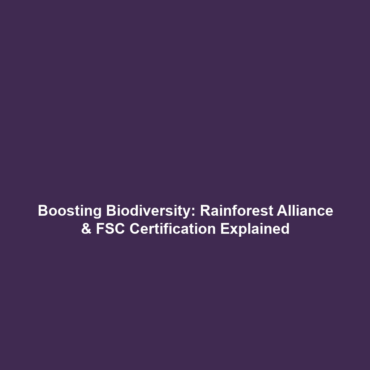Certification Schemes for Sustainable Forestry: Impact on Deforestation & Biodiversity Loss
In the face of rising concerns over deforestation and biodiversity loss, certification schemes such as the Rainforest Alliance and the Forest Stewardship Council (FSC) play a crucial role in promoting sustainable forestry practices. These schemes are designed to recognize and promote environmentally responsible forest management while balancing economic viability and social responsibility. As industries increasingly face pressure to adopt sustainable practices, understanding the impact of these certification schemes becomes paramount for environmental conservation and biodiversity protection.
Key Concepts of Certification Schemes
Principles of Sustainable Forestry
Certification schemes like the Rainforest Alliance and FSC have established key principles that govern sustainable forestry. These principles typically focus on:
- Ensuring the maintenance of ecological processes and biodiversity
- Upholding the rights of indigenous peoples and local communities
- Implementing responsible harvesting practices that reduce environmental impact
- Promoting the sustainable use of forest resources
By adhering to these principles, certified forests contribute to the broader goal of mitigating deforestation and preserving biodiversity, which are critical global challenges.
Applications and Real-World Uses
The practical applications of certification schemes such as the Rainforest Alliance and FSC are evident across various sectors. These include:
- Consumer Goods: Products with Rainforest Alliance or FSC certifications promote forest conservation and sustainability, thereby encouraging consumers to make responsible purchases.
- Timber Industry: Certified timber ensures that wood products are sourced from sustainably managed forests, reducing pressure on natural ecosystems.
- Conservation Programs: Many non-governmental organizations and conservation initiatives employ these certification standards to guide restoration and sustainable practices in deforested regions.
These applications illustrate how certification schemes are actively utilized to combat deforestation and support biodiversity conservation.
Current Challenges
Despite the importance of certification schemes, several challenges hinder their effectiveness. These include:
- Limited Awareness: Many consumers are unaware of certification labels, which undermines the market impact.
- Cost Barriers: The certification process can be expensive and logistically challenging for smaller forestry operations.
- Fraudulent Certification: Instances of mislabeling and fraudulent certifications dilute the trustworthiness of the scheme.
- Enforcement Issues: Gaps in monitoring and enforcement can lead to non-compliance among certified entities.
These issues represent significant challenges in promoting the success of certification schemes in addressing deforestation and biodiversity loss.
Future Research and Innovations
Future research into certification schemes like the Rainforest Alliance and FSC is poised to unveil new innovations that enhance their impact on sustainable forestry. Key areas of focus may include:
- Technological Advancements: The integration of satellite monitoring and blockchain technology could improve transparency and traceability in certified supply chains.
- Community Engagement: Strategies that involve local communities in decision-making processes may bolster the effectiveness of sustainability measures.
- Policy Integration: Cooperation between governments and certification bodies could strengthen regulations and promote broader adoption of sustainable practices.
Such innovations will likely play a critical role in enhancing the effectiveness of certification schemes in mitigating deforestation and preserving vital biodiversity for future generations.
Conclusion
The Rainforest Alliance and Forest Stewardship Council (FSC) certification schemes represent crucial initiatives for promoting sustainable forestry practices. By providing frameworks that facilitate environmental stewardship while supporting economic and social factors, these schemes significantly contribute to addressing the challenges of deforestation and biodiversity loss. To enhance their effectiveness, it is essential for stakeholders—manufacturers, consumers, and policymakers—to collaborate and support these initiatives actively. For further reading on related topics, explore our articles on sustainable forestry practices and biodiversity conservation efforts.

Leave a Reply